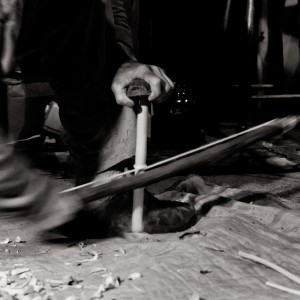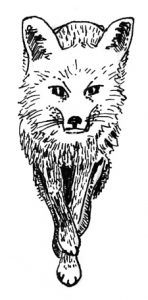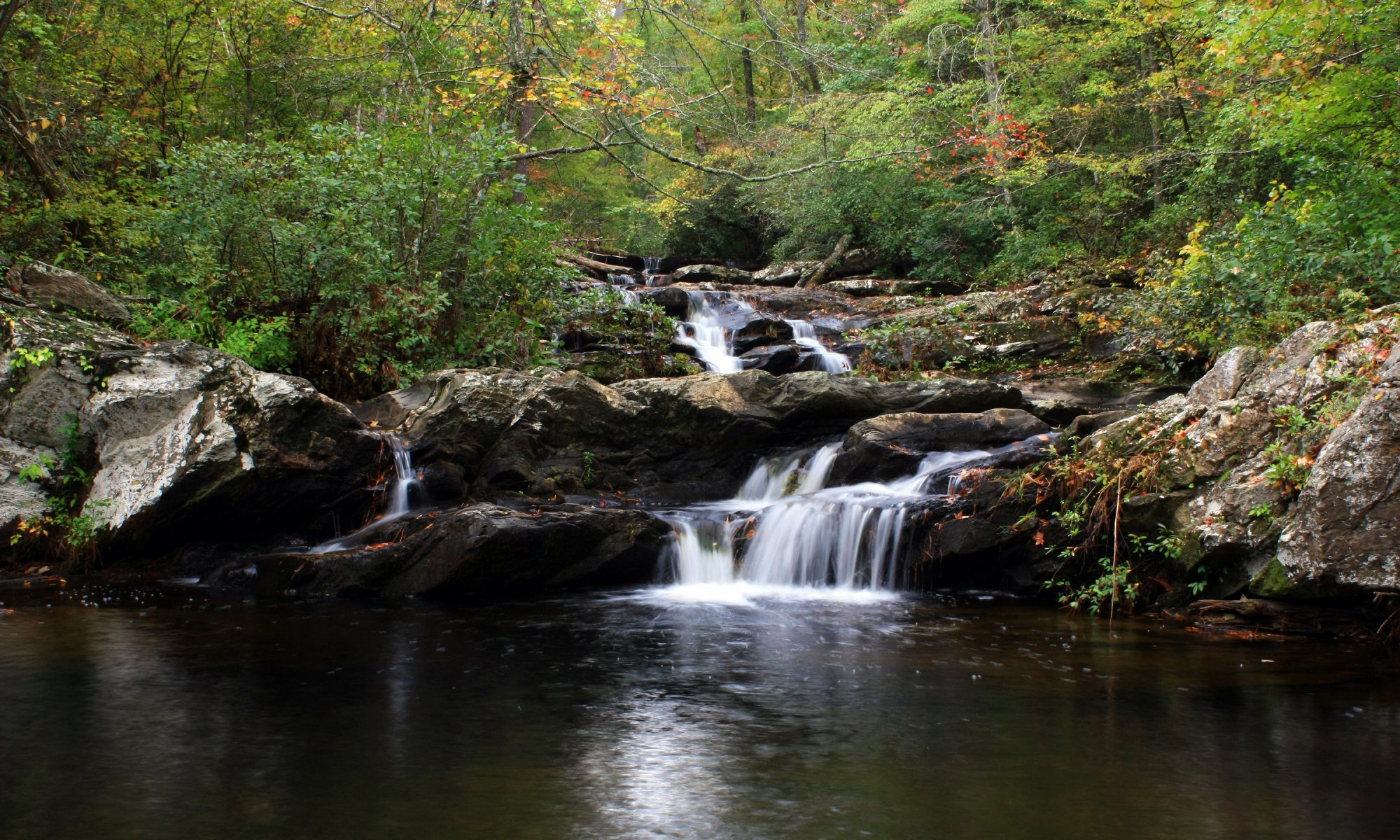This article appears courtesy of the North Georgia Journal.
Lessons from the Ancient Ones
BY CHATTY WIGHT

Since the first time my daddy took me by the hand to walk along a wooded trail to discover wild grapes (muscadines), salamanders, wild ginger, and the endless secrets of the forest, I have been hooked. I will forever be a student of nature. It is for this reason that a large shade tree in my backyard is like an old friend today. I’ve watched this tree grow in botanical leaps and bounds over the years. I know well its big orange, yellow and green blossoms, and its peculiar winged seeds that churn the autumn air like tiny helicopters. In the summer, I especially appreciate its unique leaves, notched at the tip rather than pointed like all its green neighbors. The tulip poplar is so common in north Georgia, I guess I’ve strolled past thousands in my lifetime. But today, as a light rain begins to shower its broad leaves, I look more closely and think back to the weekend I recently spent at a mountain wilderness school called Medicine Bow.
First of all, I learned there that the tulip poplar isn’t really a poplar at all, but a magnolia. Is this nit-picking? After all, even most books on trees call it “yellow poplar” or “tulip poplar,” not to mention the 99 out of 100 old-timers in the mountains who will tell you the same thing. But the tree’s correct identity is worth knowing. That is if you’re ever in a desperate situation and are trying to create a spark for a fire by rubbing two pieces of wood together.
Medicine Bow is located in the mountains near Dahlonega. It’s a place to learn about nature,no matter what your age. There are courses offered in plant study, flute-making, archery, tracking, stalking, hide-tanning, and canoeing… each taught by an instructor named Mark Warren who owns Medicine Bow.
Warren is a dedicated teacher, but it wasn’t until I took the course that I learned just how knowledgeable he is in his profession. Just this year, he won the national championship in white-water canoeing. He also placed eighth in the world championship longbow tournament.
His best credentials, however, undoubtedly involve his ability to teach. He is respectful of each student’s pace, and is clear and proficient in his demonstrations.
I chose a workshop on wilderness survival. It’s not that I really expect to be a plane crash survivor on a remote mountain range. I simply wanted to learn more about this place where I live – these southern Appalachians – and maybe find a new sense of self-reliance for my camping trips. Well, all this and more were experienced during my work shop. Even my reverential respect for the natural world was lifted to a new level in this class, because all of us began to look at the forest through the eyes of those who once called these mountains home.
The Cherokee, long ago, walked these same trails and satisfied all their needs from the plants, animals, rocks, and streams of their vicinity. These are all things we take for granted today, with stores ready-made in our towns to sell us whatever we desire.
The ancient ones, however, coaxed everything they needed from the forest, be it needle and thread, glue, clothing, weaponry, food, medicine, tools, shelter… the list is endless. In our class, Mark did not thrust us into a survival ordeal, but provided a hands-on experience which allowed us to learn the skills which we could later implement at our own pace. He has been teaching woods lore for over 25 years and knows that it is unrealistic for someone to put all the knowledge together immediately without lots of practice. In fact, Mark suggests that we participants choose one aspect of survival – be it food, fire, shelter, water, hunting, medicine, etc. – to pursue on our next camping trip. Then he instructs us, for instance, to leave our matches at home on that trip, but bring the requirements for all our other needs. On the next camping trip, we’d leave the tent at home… and so forth. The Native Americans learned from the animals and from ingenuity, trial and error. And while the old adage “watch what the animals eat and follow their lead” is unreliable (and even dangerous), much can be gained from observing the survival skills of the animals.
We began our class with the lesson of the squirrel who builds its wind-, rain-, and cold-proof nest from three different parts of a tree: leaves, sticks, and inner bark. With the squirrel as my inspiration and Mark as my instructor, I built myself a warm and snug wilderness home.
I began by making rope from the bark fibers of- guess what? – the tulip magnolia tree. With this rope and sturdy sticks, I constructed something I had never imagined I could make… a rake. This tool saved me hours of work in the gathering of dead leaves – thousands of them – which became the main insulation of my survival hut. In a few hours, I stepped back and admired the finished product that could shelter me from a rainy and chilly February night. No… that’s not quite right. It would integrate me with the night. And, it did.
 The next project was a matchless fire. From a flat piece of wood splintered from a dead tree, Mark stripped fibers of inner bark and fluffed them into a “nest” and placed this beneath some dry twigs. Slightly larger twigs and broken branches were placed above this. Mark then began twirling a thick, dried weed stalk between his palms so that it bored into a piece of wood into which he had carved a notch. As he continued twirling, gradually, a gray wisp of smoke began to curl from the point of friction, and ultimately, hot ash dropped from the wood and down the notch into the “nest” he had built. When he gently blew into the nest, a red coal glowed and burst into a yellow flame. I thought I had seen pure magic. Mark explained that some trees – like the poplar – are more obliging in the creation of fire than others. The tulip magnolia tree, in contrast, tends to be a little damp and can be tougher. Aha! I thought to myself… The reason to discriminate between tulip magnolia and poplar. Now I grant you… the process of twirling the wood with your hands to create the friction necessary to produce the coals is a cumbersome process. Back in the dawn of time, however, some brilliant Paleolithic inventor developed a small bow which was used to rotate the spindle like a power tool, making the entire process imminently easier. Mark demonstrated this improved technique and told us this would be our method. “But even with this added improvement, it still will be a challenge for you,” he cautioned. “But once you make fire in this manner, you’ll feel something new inside yourself… a kind of humble power. It is quite a feeling to stand before a tree and know that the two of you are about to collaborate in the creation of fire.”
The next project was a matchless fire. From a flat piece of wood splintered from a dead tree, Mark stripped fibers of inner bark and fluffed them into a “nest” and placed this beneath some dry twigs. Slightly larger twigs and broken branches were placed above this. Mark then began twirling a thick, dried weed stalk between his palms so that it bored into a piece of wood into which he had carved a notch. As he continued twirling, gradually, a gray wisp of smoke began to curl from the point of friction, and ultimately, hot ash dropped from the wood and down the notch into the “nest” he had built. When he gently blew into the nest, a red coal glowed and burst into a yellow flame. I thought I had seen pure magic. Mark explained that some trees – like the poplar – are more obliging in the creation of fire than others. The tulip magnolia tree, in contrast, tends to be a little damp and can be tougher. Aha! I thought to myself… The reason to discriminate between tulip magnolia and poplar. Now I grant you… the process of twirling the wood with your hands to create the friction necessary to produce the coals is a cumbersome process. Back in the dawn of time, however, some brilliant Paleolithic inventor developed a small bow which was used to rotate the spindle like a power tool, making the entire process imminently easier. Mark demonstrated this improved technique and told us this would be our method. “But even with this added improvement, it still will be a challenge for you,” he cautioned. “But once you make fire in this manner, you’ll feel something new inside yourself… a kind of humble power. It is quite a feeling to stand before a tree and know that the two of you are about to collaborate in the creation of fire.”
He was right. That afternoon, I coaxed fire from a sycamore. And I did feel that humble power. I still do. We gathered wild foods from pines, birches, basswood, Indian cucumber root, Solomon’s seal, cattails, – even from a wasp nest! – and ground nut from wapato, which is a favorite Cherokee tuber. We learned how to use natural medicines to stop bleeding; halt infections; cure nausea, bee stings, fever, and much more. I was stunned at so many plant uses. Every time someone stopped to ask Mark about an herb or tree or shrub, he had a story to tell about it, always careful to elaborate on scientific corroboration.
Medicine Bow’s 35 acres provided us with swamp, marsh, creek, lowland and highland forests for our botanical study, but Mark reminded us that we were merely scratching the surface. Many of his workshops deal exclusively with plant identification and usage. “It takes years of dedicated study to become competent with plants,” he advises, “but the process speeds up with a human guide in the field. Just never take a chance with a plant if you’re not certain of its identification.
That could be a costly mistake. Some plants have developed impressive poisons for their own defenses.”
That night, we cooked our wild foods in an underground pit lined with fire-heated stones and enjoyed a delicious meal. Later, around the central campfire, using chunks of dead tree, hot coals, and blow tubes of hollow stems of Joe Pye weed, we fashioned wooden bowls in which we boiled creek water by dropping in fire-heated stones. We thus learned the most important of all the survival skills – the acquisition of drinkable water.
 Mark Warren moves a little differently than most people I know. He walks with a subtle grace as if his torso is mounted on shock absorbers. The next day, I found out why. He introduced us to the technique of stalking… and I don’t mean the stalking of humans either, but animals. This ancient method of approaching wild animals undetected by eluding their senses of smell, sight and sound, is a very tedious but effective method of hunting. It was widely used by prehistoric man. Learning stalking was like taking a course in wilderness Tai Chi, because we slowed our movements to a snail’s pace. Again, we drew from animal masters, learning the skills of the fox, deer, and heron.
Mark Warren moves a little differently than most people I know. He walks with a subtle grace as if his torso is mounted on shock absorbers. The next day, I found out why. He introduced us to the technique of stalking… and I don’t mean the stalking of humans either, but animals. This ancient method of approaching wild animals undetected by eluding their senses of smell, sight and sound, is a very tedious but effective method of hunting. It was widely used by prehistoric man. Learning stalking was like taking a course in wilderness Tai Chi, because we slowed our movements to a snail’s pace. Again, we drew from animal masters, learning the skills of the fox, deer, and heron.
When Mark explained the stalker’s primary tool is patience, one of the students laughed, ready to surrender, claiming she had no patience. “Yes, you do,” countered Mark. “The pace of our culture has suppressed it in you. Out here, you have every reason to let it surface, because in the wild, patience is not the exception, but the rule.”
It was true… As soon as I embraced that idea and learned the value of slowness, I found I could do what any other animal could do when necessary. “It is a wonderful metaphor for our lives,” Mark suggested. “Stalking teaches us to be content with the actual spot where we are standing during our abored approach, for it represents the accomplishment of having reached that spot. To be thinking too far ahead, anxious to get to that next spot . . . is what usually foils the attempt.” “How did the Indians get all that patience?” someone asked. “Actually,” Mark said, “they might not have understood this idea of patience versus impatience. They simply did what needed doing.”I’ve thought about that a lot since that lesson. Like right now as I gaze out my rain-streaked window at the tulip tree. I notice the dead branch where strips of inner bark hang in banners.
I know now that a squirrel tore these fibers for her nest for the comfort needed on days such as this. I think of the rope, clothing, or fire-tinder I can make from these fibers, the basket from the outer bark, the excellent kindling from the soft, porous twigs, and the fire that lies somewhere deep in the heart of the wood waiting for skilled hands to bring it out. The Cherokees even made their canoes from this tree in much the same manner as I had made my wooden bowl In this quiet moment that I’ve given myself before leaving for work, I realize how much more I see in this one tree than I did a week ago. It is a very nice moment. I plan to have a lifetime of them!
If you would like to talk more about Medicine Bow, give Mark a call at 706-864-5928 or email him at medicinebow@att.net
Mark Warren has packed 45 years of teaching into a four-volume series of books called “Secrets of the Forest.” Check them out here!

